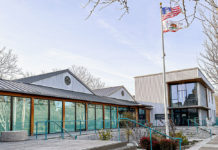This tributary to the Russian River near Duncans Mills got its
name from the lingering frost its steep, north-facing watershed
attracts in deep winter.
But that’s not Freezeout Creek’s only claim to fame.
Despite its relatively compact, 3-square-mile watershed,
Freezeout, like the larger, 9-square-mile Willow Creek watershed
just over the ridge to the south, as well as most of the other
coastal streams in the region, used to provide a nursery for the
tens of thousands of now endangered Coho salmon that once filled
the length of the Russian River and its tributaries during spawning
runs.
They were dense enough then that Coho salmon and their kin
supported a commercial river fishery for a while.
These days, following more than a century of logging, dams,
agriculture and urbanization, the Russian River, which also once
boasted a world-class steelhead fishery isn’t what it used to
be.
What little remains of its wild steelhead and salmon populations
are listed as endangered or threatened both by state and federal
agencies and some, including Coho salmon, have become extinct in
most local streams where they once flourished.
As a result, federal, state and local agencies, environmental
groups and individuals have for the past several years pitched in
to help bring the fish species, particularly regional Coho, back
from the brink of being forever gone.
Biologists believe Coho numbers dropped in the late 1990s to
only about 100 adult fish in the entire Russian River system; a
decline they say has been caused by loss and degradation of
freshwater habitat and changing ocean conditions.
Surveys of prime Coho streams found no returning spawners
several years in a row. According to them, Coho numbers have fallen
from between 6 and 15 percent of their abundance during the 1940s
throughout their entire California range.
As a result in 2001 California Department of Fish and Game
biologists captured about 200 juvenile Coho from Russian River
tributaries as part of the multi-agency collaboration named the
Russian River Coho Salmon Captive Broodstock Program formed in
2001.
The wild fish were carefully gathered, vaccinated to prevent
disease and raised to adulthood in specially designed tanks at the
Don Clausen Warm Springs Hatchery at Lake Sonoma.
Two years later the adult fish were spawned at the hatchery and
their progeny subsequently reared too in order to restock Russian
River tributaries where Coho historically lived.
Most important to the effort, in addition to the massive funding
from federal, state and other sources to perpetuate the fishery
through various projects, are landowners, since 95 percent of the
Russian River watershed privately owned have pitched in to
help.
Like for example Barry and Sylvia Fisher, and Harvey and Ralph
Henningsen, owners of adjacent properties on Freezeout Creek where
several weeks ago a second batch of Coho young were released by
biologists as part of the on-going Russian River Coho project.
“We’re really thrilled about the project,” said Sylvia Fisher, a
former Occidental area elementary school teacher, who along with
her husband, has been coming to the family property to camp and
recreate for the past 50 years.
“Barry has been very involved in creek restoration for some
time. It’s very exciting.”
Barry Fisher, a former Sebastopol high school principal and a
director of the Gold Ridge Resource Conservation District, said he
was first contacted by state fisheries biologists about twenty
years ago who were granted permission to access his property to
study a portion of the stream there as possible fish habitat.
“Then about a month ago,” he said, “they called again about
planting Coho there. Since a lot of Gold Ridge’s work involves
stream restoration and conservation, we of course gave total
support.”
He said a total of about 2,000 fish will have been planted when
the next operation is planned for sometime in October, just before
the fall rains.
“The point is to see which time periods work best, summer or
winter before the fish go to sea.”
He said a few days ago, biologists went snorkeling to see how
the first transplants were doing, and a number were found to be
doing quite well.”
Fisher said since it takes about three years for Coho to return
to spawn, “We’re in hopes of a new run in the creek, there were
very few, if any left.”
Henningsen, who happens to be Sylvia Fisher’s brother, as well
as a prominent Sebastopol portrait photographer, said it was an
honor to have Freezeout Creek picked as a potential Coho
restoration stream.
“I’ve been coming out here since I was a kid,” Henningsen, who
is 65, said.
“I can remember as a five-year-old seeing big fish coming up to
spawn, although I didn’t know what they were doing,” he said,
adding, “My Dad brought us up to think that all life is sacred and
how I feel about it. I just think if the whole Russian River
drainage system could be brought back, that would be
fantastic.”
“The goal of the program is to not only prevent local
extirpation, but to restore self-sustaining populations of Coho to
tributaries throughout the Russian River basin,” said Benjamin
White, a program biologist with the Pacific States Marine Fisheries
Commission at Warm Springs Hatchery.
White said in the Russian River the Coho collected and
transported to Warm Springs Hatchery served as the program’s
broodstock population.
“Broodstock are reared their entire lives in fresh water and are
spawned according to a breeding matrix to avoid inbreeding and to
maximize genetic variation. The off-spring are then released into
multiple tributaries within the watershed that historically
supported wild runs of Coho,” he said.
Then, using water-filled backpacks fitted with aerators, crews
hike along the creeks releasing fish at low densities into the best
available habitat. Since its inception, White said, the restoration
program has completed six spawning cycles and released nearly
350,000 juveniles throughout the watershed.
Other agencies included in the program include the Sonoma County
Water Agency, whose activities spokeswoman Ann DuBay said the
agency helps fund the hatchery project and consults with biologists
and others.
“In regard to other efforts related to Coho, using a variety of
techniques — including snorkeling surveys, electro fishing surveys,
live traps (where fish are measured and released daily) monthly
seining and a fish ladder with underwater video monitoring
equipment,” the Sonoma County Water Agency collaborates with
multiple entities in monitoring and studying Coho in the Russian
River, Dry Creek and the estuary at Jenner, she said.
In addition to Freezeout, she said, fish from the program have
been released into Mill, Palmer and Grape and Ward Creeks near
Healdsburg and Dutch Bill Creek, Green Valley, Sheephouse,
Freezeout Creeks, as well as multiple tributaries to Austin Creek,
in the downstream stretch of the Russian.
She also said the water agency “is being mandated by National
Marine Fisheries Service’s Russian River Biological Opinion to
change the way we operate our water supply system to improve
conditions for Coho, steelhead and Chinook.”
“Over the next 13 years,” she added, “we will be enhancing
habitat on six miles of Dry Creek; asking for lower flows in the
Russian River to provide better conditions for young salmon and
steelhead; and altering the way we open the sandbar that sometimes
closes the mouth of the river near Jenner.”
Meanwhile, although Gold Ridge RCD wasn’t involved directly in
the Freezeout planting, it has been involved in Coho restoration
efforts, and so far successfully in Salmon Creek and other streams
that are tributaries to the Russian River.
“There is a lot going on right now with the goal of Coho
recovery up and down the north coast,” said Gold Ridge RCD
Executive Director Lisa Hulette. “We have been involved in a number
of the Coho releases conducted by DFG’s Coho broodstock program.
Specifically, this year, we have been involved in fish releases in
Salmon, Dutch Bill and Green Valley Creeks. It seems these releases
have been successful and spawning has occurred!”
Hulette said most of the current restoration efforts are focused
on keeping water in the creeks. “We are working with a number of
partners to develop off-channel water storage options for land
managers so that more water stays in the creek, yet landowners have
more water security in the form of storage.”
Indeed, said Kara Heckert, executive director of the Sotoyome
Resource Conservation District, working with landowners in both the
up and down river areas of the river, including Mill and Felta
creeks near Healdsburg as well as in Sheephouse Creek and Austin
Creek in the lower river.
“One of our major concerns is working with landowners to try and
reduce the amount of sedimentation and erosion that ends up
smothering the redds – the spawning nests – of salmon and
steelhead,” she said. “Right now between Austin and Sheephouse
creeks we are assessing up to 150 miles of roads, including old
logging roads, and working with landowners to determine and improve
water quality as well as working on plans to increase in-stream
fish habitat and removed spawning obstacles like old culverts.”
“For example, one of the last places wild Coho have been seen is
in Felta Creek,” she said. “That’s why working with landowners is
so important.”
59.6
F
Healdsburg
April 18, 2025







